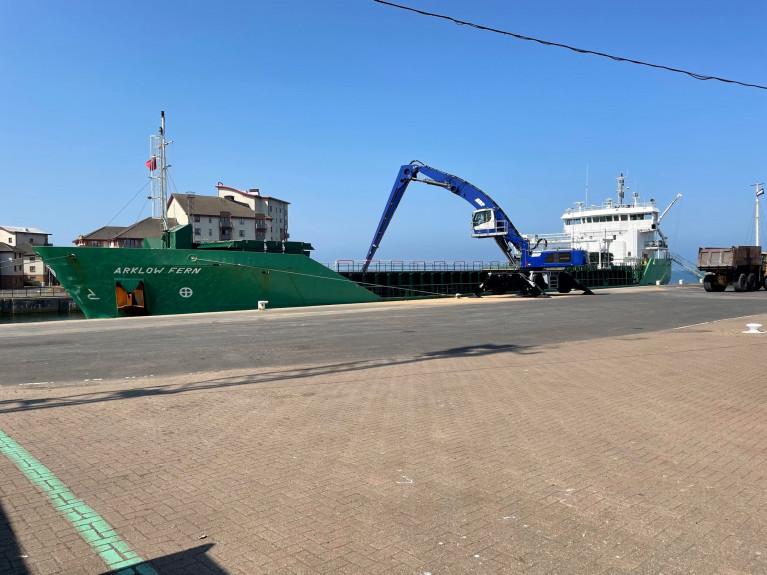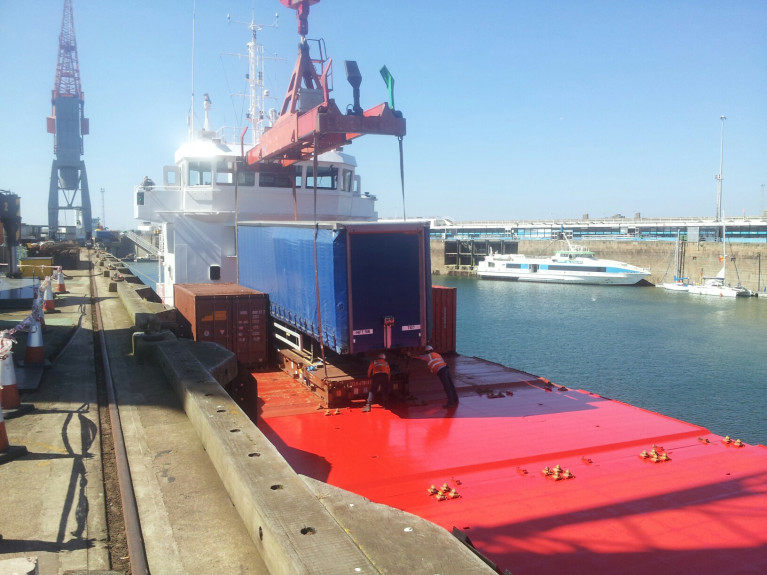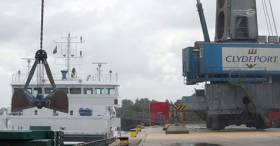Displaying items by tag: Irish cargoship
Irish Cargoship With Wheat Partly for Scottish Whisky Is Handled More Sustainably between ABP Ports
An Irish flagged cargoship, Arklow Fern with a cargo of wheat partly destined for the world-famous Scotch whisky industry, recently made a coastal passage between two ports operated by Associated British Ports.
On board the 2010 Spanish built Arklow Fern was 4,393 tonnes of wheat which was taken by sea, rather than road, a saving 61,535 lorry miles. According to ABP, this more sustainable form of transport, approximately equated to a reduction of 82 tonnes in carbon emissions.
The 89m long cargoship on 20th July, completed the sailing from the ABP's Port of Ipswich in south-east England to another ABP port, Ayr in south-west Scotland.
At both ends of this sustainable maritime supply chain, the stock of wheat cargo can be stored efficiently, at the quayside in the Suffolk Port of Ipswich, and in store at the Port of Ayr. The latter port in Ayrshire, specialises in handling dry bulks, including salt, animal feed, heavy lift and forest products.
Andrew Harston, Regional Director, ABP said, “ABP is keen to support our customers in creating more sustainable supply chains. This shipment of wheat is a great example of a collaborative approach to make a positive difference towards our shared sustainability goals and shows how shifting to shipping from road reduces carbon emissions significantly.”
Together with customers, ABP’s Scottish ports of Ayr and Troon contribute over £40 million to the UK economy every year, including £28 million locally.
In another development that took place earlier this year, ABP completed its investment of £2.2 million to upgrade all front-line machinery at its Port of Ayr, demonstrating its commitment to its customers and mission of keeping Britain trading.
Also along the Ayrshire coast is ABP’s Port of Troon, which is celebrating 21 years of running the TimberLINK service, which handles over 100,000 tonnes of timber each year and has reduced carbon emissions by more than 1,200 tonnes every year since 2000.
In both its Scottish ports, ABP maintains the region’s competitiveness, agility and resilience by continued investment in infrastructure, equipment and systems, while supporting its own sustainability goals as well as those of its customers.
Deal or No-Deal: Irish Flagged Cargoship from Cork Dockyard Heads to UK's 'Ferry' Brexit Waters
So where next? Afloat posed the question after the Irish flagged Huelin Dispatch departed Cork Dockyard last week and to initially anchor offshore prior to the ship's arrival in UK waters this week, writes Jehan Ashmore.
The Dundalk Shipping (DSC) Co Ltd owned Damen Combi-freighter after the dry-docking had for several days in Irish waters awaited orders from a charterer while off the mouth of Cork Harbour.
Now the cargoship is in the southern North Sea at Deal Anchorage off the east Kent coast. Deal is located where the English Channel meets the North Sea and is located equidistant between Dover (Britains busiest ferryport) and Ramsgate. Both ports are 8 miles apart of Deal.
This evening the aids to navigtion tender THV Patricia of Trinity House which departed their main marine depot in Harwich, Essex is too anchored off Deal though the Irish cargoship lies closer to Walmer as explained further below.
Huelin Dispatch had sailed through the English Channel and a transit of the Strait of Dover before taking anchorage offshore off Deal which took place on Monday night. The repositioning voyage might suggest the anchorage is more suited in a sea region geographically closer to numerous central north-west Europe ports and hence advantageous when the charterer recieves a call for further orders.
Nearby of Deal to the north is the Port of Ramsgate where in early 2019, the port hit the UK national headlines as one of several ports proposed to serve the UK in the event of a 'No-Deal' to secure essential and additional freight capacity with the EU and the rest of mainland Europe.
In a package announced in 2018 by the UK Government costed at £108m were contracts to French operator, Brittany Ferries, the Danish giant DFDS and Seaborne Freight to launch a service to Belgium by reviving the Ramgate-Ostend service subsequently cancelled.
However, The UK Transport Secretary reported Channel 4 News, faced controversary and calls for his resignation last year after the cancellation of a £14 million contract with ferry company Seaborne Freight. The government pulled the rug on the contract after revealing that Arklow Shipping – a firm which was set to be a majority shareholder in Seaborne – had itself backed out.
Channel 4 News also revealed that that company had never agreed any contract and blamed the UK government for pushing the deal through too fast.
Overall the most bizarre aspect of the story is that Seaborne Freight glaringly never traded nor had any ferries for that matter and therefore experience in running any such operation.
By coincidence the British game show, Deal or No Deal hosted by Noel Edmonds, was broadcast by Channel 4 for just over a year until it ceased in December 2016.
In that same year, ASL was a client of Cork Dockyard with the call of Arklow Rose, following the closure of Dublin Graving Docks Ltd with Arklow Fame becoming the last 'merchant' ship. The 220m graving dry-dock however was afterwards temporaily used for work on the 'static' museum timber built tallship Jeanie Johnston based on the nearby river Liffey.
As for Cork Dockyard which in 1995 was acquired by the Doyle Shipping Group (DSG) though the facility in Rushbrooke near Cobh is branded as the marine repair division in the Cork based shipping group.
Until recent years, Cork Dockyard has its own dedicated website, but it would appear for corporate rebranding purposes now forms part of the group's website of diverse shipping operations. Among them is shipping agency services with offices in all main Irish ports north and south.
As Afloat previously highlighted Cork Dockyard had among previous owners, the Damen Group which built Huelin Dispatch for Dundalk Shipping in 2012 at Bergum in the Netherlands. It is in that nation where at a shipyard in Schiedem where Townsend Thoresen Ferries (TTF) had also custom built the Free Enterprise VII completed in 1973, firstly to operate on the Dover-Calais/Boulogne Zeebrugge routes.
As for the present where Huelin Dispatch is in fact at anchorage closer to the other coastal Kent town of Walmer, where ferry aficionado's will note this location was the place name given to the renamed TTF ferry. That been the Pride of Walmer which continued to serve on the Strait of Dover but understood only to have operated to the Belgium port.
Before re-entering service, the ferry was radically rebuilt in Germany and not for the better at least in terms of exterior aesthetics and to put it politely, the ship emerged with a most ungainly appearance.
The 'Walmer' by 1987 was officially registered as part of new owners P&O Ferries which renamed the ferry Pride of Rathlin reflecting the route it was transferred to closer to home. This was the North Channel link of Larne-Cairnryan where the almost 30 year old ferry would remain until withdrawn from the Northern Ireland-Scotland run in late 2000.
Another ferry related connection with Huelin Dispatch as it lays offshore of Kent is that Deal too was also used to form part of a ferry renaming in the case of Brittany Ferries Poole-Cherbourg route ferry Barfleur. This arose following a short charter of the English Channel route ferry to DFDS Seaways in 2012 which saw the Deal Seaways emerge on the Dover-Calais route but the French flagged ferry returned to routine duties and regained its original name.
Barfleur would criss-cross the path of Huelin Dispatch when DSC chartered their first custom built cargoship with the inaugural charter to Channel Island Lines. Afloat will have more to report on the current status of the ferry given the Covid-19 crisis and CIL.
The Huelin Dispatch had operated regular freight services out of Southampton to Guernsey and Jersey, however in more recent times Afloat tracked the ship trading in Scandinavian waters prior to the recent dry-docking.
#Ports&Shipping - An Irish flagged cargoship became the first agri-bulk vessel for global animal feed trader ADM Arkady, a client of Peel Ports Glasgow (Clydeport) where a facility has undergone upgrading.
According to the UK ports group, the Arklow Ruler had loaded in France and arrived in Clydeport on 15 June with more than 4,000 metric tonnes of animal feed.
The 2006 built short-sea trader berthed in the King George V Dock which marked a significant first milestone in the long-term contract between Peel Ports and the supply chain leader which was announced earlier this year.
Peel Ports have extensively refurbished the on port agri-bulks storage facilities at KGV to ensure the highest standards of compliance are achieved to bring them in-line with other ports of the group. The works also included investment in a new IT platform as well as plant and cargo handling equipment.
The TASCC and ATEX compliant warehousing will become ADM’s new Scottish distribution hub.































































